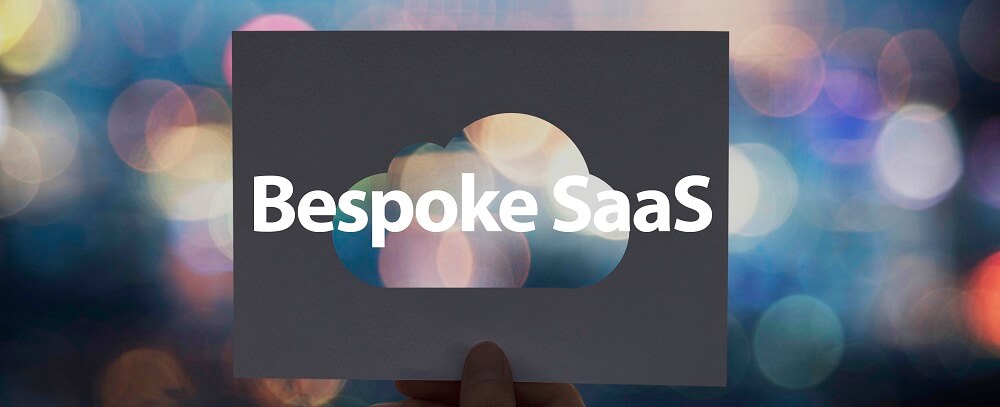Bespoke SaaS

SaaS companies have been some of the big winners during the time of the pandemic. As traditional servers became in accessible, businesses moved rapidly to shift business processes to the cloud. SaaS solutions providing essential services saw a surge of demand like never before – driving up revenues and valuations.
The advantages of SaaS
SaaS-based solutions offer several advantages over traditional computing. They’re ideally suited for users to work from anywhere. A user can work with any device, from any network – which is what makes it so ideal in today’s WFH world. It makes it easy on IT teams – they don’t have to worry about hardware obsolescence, patch updates, infrastructure downtime, change management etc. Businesses most likely can reduce IT staffing as a result and also reduce capital expenditures. Most SaaS solutions offer global points-of-presence and redundancy – ensuring a very high SLA even when serving the most remotely located users model? Is it all upside?
SaaS based solutions have also forced business to change their security stance to rely more on Zero Trust based security rather than the traditional peripheral security models. Zero Trust is a more robust approach which relies on centralized authentication, augmented with multi-factor methods, while reducing the attack surface using principle of least privilege.
So have we found the perfect operating model? Is it all upside?
SaaS based solutions have also forced business to change their security stance to rely more on Zero Trust based security rather than the traditional peripheral security models.
SaaS Perfect?
To answer this, it is important to understand what businesses found appealing about the on-premise model in the first place. Sure, it is easy to dismiss most on-premise advocates as ‘dinosaurs’, ‘hanging on to the past’, and attribute their thinking to laziness or inertia. But deeper and objective conversations with customers reveal several concerns like high SaaS/cloud costs, sunk investments in capital expenditure, regulated industry requirements, security and privacy concerns etc.
After many such conversations, I have come to the conclusion that neither model (complete SaaS or complete on-Premise) is perfect. There is a need for a combined approach – which gives customers the flexibility to tune the system the way they need it.
In other words, Bespoke SaaS.
Watch Webinar: A Modern SaaS Approach to Data Protection & Resiliency
Bespoke SaaS
While SaaS is clearly ideal for employees working from homes, the reality that we’re likely to see emerging out the pandemic is a mixture of working models. Companies are clearly letting (and even preferring that) some employees work out of offices – while others may be allowed to continue working from home. The working arrangement will be far from black and white – and will clearly vary between businesses.
It is entirely possible that employees of a certain categories/bands/work-functions will be asked to work out of their office for reasons of data security or compliance. And for the same reasons, companies may be reluctant to let such employees rely on a fully hosted/SaaS solution.
Bespoke SaaS allows the customer to mix and match elements in the software offering to allow certain workloads to run on-premise, while still allowing others to be hosted in the SaaS cloud. This is not a common approach that most SaaS vendors take or even encourage – but we’re seeing a clear demand for this.

At Parablu over the last year, we’ve helped several of our existing customers migrate from an on-premise setup to our fully-hosted, SaaS model. But we’ve also helped a number of them migrate to a bespoke SaaS model to satisfy internal security and compliance needs – by letting them run a portion of their overall Parablu workload on their premises – while still retaining the benefits of centralized management.
Bespoke SaaS allows the customer to mix and match elements in the software offering to allow certain workloads to run on-premise, while still allowing others to be hosted in the SaaS cloud.
As an example, 75% of a company’s staff could be working from home and be backing up their endpoints to our SaaS cloud. 25% that work from the office backup their endpoints to an on-premise backup server. The on-premise and cloud workloads exchange meta-data to sync up and provide a single/complete view to the IT Administrators. The business can still centrally manage the whole set up as a single unit seamlessly.
Handling Shades of Grey
How many solutions provide this type of flexibility – like we’re doing at Parablu? I truly don’t know. But to service customers, we see this as an important step. While it would have been easy to adopt a “take it or leave it” stance as most SaaS vendors are wont to do – we worked with our first few customers and perfected this model. We not only helped on-premise customers move to a bespoke model, we even helped fully SaaS hosted customers move to a bespoke model.
In my opinion, most solutions handle the black and white easily. The good ones are those that handle shades of grey.
Any thoughts? Write to us at info@parablu.com. We would love to hear from you.





